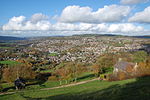Stancliffe Hall
Boys' schools in DerbyshireCountry houses in DerbyshireDefunct schools in DerbyshireEducational institutions established in the 1900sEdward Middleton Barry buildings ... and 3 more
Grade II listed buildings in DerbyshireGrade II listed housesUse British English from February 2023

Stancliffe Hall is a grade II Listed building on Whitworth Road in the settlement of Darley Dale, near Matlock, Derbyshire.
Excerpt from the Wikipedia article Stancliffe Hall (License: CC BY-SA 3.0, Authors, Images).Stancliffe Hall
Whitworth Road, Derbyshire Dales
Geographical coordinates (GPS) Address External links Nearby Places Show on map
Geographical coordinates (GPS)
| Latitude | Longitude |
|---|---|
| N 53.1721 ° | E -1.6012 ° |
Address
Whitworth Road
DE4 2HH Derbyshire Dales
England, United Kingdom
Open on Google Maps








